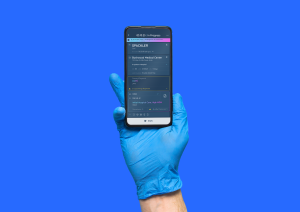Claimocity Claims
Provider Credentialing:
What You Need to Know

Imagine treating patients for an entire month, only to discover you can’t bill for any of those services because of a credentialing issue. It’s not just frustrating, it’s a preventable financial setback that happens to providers all the time. Without proper credentialing, insurance companies won’t pay you, period. Your medical expertise means nothing to payers without the right paperwork in place. Understanding the credentialing process is the key to avoiding these costly mistakes.
In this guide, we’ll walk you through everything you need to know about credentialing as an inpatient provider.
What is Provider Credentialing?
Credentialing is the process that makes sure healthcare providers are fully qualified to deliver medical services. It’s how hospitals, clinics, and insurance networks verify a provider’s qualifications including education, training, licenses, certifications, references, work history, and more. Think of it as the healthcare industry’s thorough background check, a necessary step to protect patient safety and maintain high standards of care.
Credentialing is essential for providers to be able to practice at a healthcare facility or join an insurance network, although it can be a headache. For inpatient healthcare providers who are already juggling multiple responsibilities, navigating the credentialing maze can feel overwhelming. That’s why understanding the credentialing process and having the right support is so important.
How Does Credentialing Work?
Credentialing isn’t just a one-and-done process. It requires providers to submit extensive documentation, which then goes through primary source verification, meaning every detail must be checked directly with the issuing organizations.
Credentialing can feel neverending, and the timeline can range anywhere from 30 to 150 days, depending on how smoothly the process goes. Staying on top of credentialing means less stress, fewer denied claims, and a stronger financial foundation for any medical practice.
The Credentialing Process
1. Pre-Application: Gather Your Documents
Before submitting an application, providers need to round up key documents:
- Personal Information: Government-issued identification, Social Security Number, date of birth.
- Education & Training: School diplomas and transcripts, residency certificates, and fellowship documentation.
- Licenses & Certifications: State medical licenses, DEA registrations, specialty board certifications.
- Work History: Detailed employment timeline and explanation of any gaps in work history.
- Malpractice Insurance: Current policy information and evidence of continual malpractice coverage.
- References: Professional and personal peers who can vouch for your clinical skills and character.
- Hospital Affiliations: List of current and previous hospital privileges.
We know this can feel like a mountain of paperwork, but providing accurate documentation is crucial in keeping your credentialing process smooth and hassle-free. Getting it right the first time saves time and prevents delays, so you can get paid for the great care you provide.
2. Submitting the Credentialing Application
Once you’ve gathered all the necessary documentation, the next step is submitting your application. Remember that accuracy is crucial at this stage. Even minor errors or omissions can cause significant delays in the credentialing timeline. Providers should prioritize applications for the insurers they bill most frequently to avoid reimbursement delays.
3. Verification and Approval
Once submitted, your application enters the primary source verification phase—where insurers meticulously verify every detail of your credentials. This is more than a casual check; they contact each original source directly to confirm your qualifications. This includes validating your education with academic institutions, verifying your work history with previous employers, and confirming your licensure status with state medical boards.
4. Follow-Up
Since credentialing takes time, proactive follow-ups are essential. Providers should regularly check the status of their application and respond quickly to any requests for additional documentation. Payors often have varying processing times, and a single missing document can cause significant delays. Keeping detailed records of submitted materials and follow-ups can help prevent delays and ensure a smoother approval process.
5. Ongoing Monitoring and Re-credentialing
Credentialing isn’t a one-time event. Most healthcare organizations and payers require re-credentialing every two to three years to ensure your qualifications remain current. This includes reverifying your credentials and reviewing your performance during the previous credentialing period. If re-credentialing deadlines are missed, the consequences can be serious. Expired credentials can lead to claim denials, lost hospital privileges, and even legal ramifications if you continue practicing without valid credentials.
Who is Responsible for Credentialing?
Credentialing starts with the provider, but depending on where they practice, different people and teams help manage the process. Solo practitioners often handle it themselves or hire a service to take care of it. In group practices, there’s usually a credentialing specialist or department making sure everything is in order. Hospitals typically have entire medical staff offices dedicated to credentialing, ensuring all providers stay compliant.
Many providers opt for third-party credentialing services that take care of the entire process, from paperwork to verification, so they don’t have to worry about tracking deadlines or dealing with administrative headaches. While providers are responsible for supplying accurate information, credentialing professionals can step in to confirm details, submit applications, and keep your credentials up to date.
How Does Credentialing Impact Revenue?
Credentialing directly affects your bottom line. A poorly managed credentialing process can trigger administrative nightmares that drain both time and money. Delayed credentialing means delayed reimbursements; without proper credentialing, a provider simply cannot bill for services. Denied claims pile up fast. When credentialing lapses or contains errors, services you’ve already provided may go unpaid, forcing you into time-consuming appeals and resubmissions. In-house credentialing steals valuable time. Managing credentialing yourself requires extensive administrative effort that could be spent elsewhere.
By staying on top of credentialing, providers can:
- Ensure timely and accurate reimbursements
- Reduce denied claims
- Improve cash flow
Having a well-managed credentialing process is a smart financial strategy. By keeping credentials up to date and avoiding preventable errors, you can maintain steady revenue, minimize billing disruptions, and continue to grow your practice.
Resources for Keeping Up On Credentialing
Navigating credentialing can be time-consuming, but it doesn’t have to be a headache. That’s why we’ve created a free checklist to help providers like you make the credentialing process organized. Get it now to stay on top of deadlines and avoid unnecessary delays.
Download the Provider Credentialing Checklist:
How Claimocity Can Help With Credentialing
Credentialing isn’t just a box to check. Missteps in this critical process can limit your ability to practice and directly impact your revenue stream. Getting it right the first time keeps your practice running smoothly. Turn the complex credentialing process into a seamless experience with Claimocity’s credentialing support. We have a team of credentialing specialists with state, payor, and specialty expertise who can take the burden off your shoulders so you can stay credentialed, compliant, and focused on what matters most.
Our team handles the details and takes the hassle out of credentialing by managing everything from NPI, CAQH, and PECOS enrollments to insurance portal oversight. We track expiration dates, send renewal alerts, and ensure your documentation stays organized—so you never miss an important deadline.
Stop worrying about administrative roadblocks. With Claimocity, you can count on:
- Accelerated initial credentialing for quicker patient engagement
- Expedited resolution of billing-related issues
- Timely fulfillment of all deadlines and requests
Don’t let the complex credentialing process hold you back. Download our Provider Credentialing Checklist to get started on the right track, and contact Claimocity today to learn how our credentialing services can transform this administrative burden into a streamlined process.


